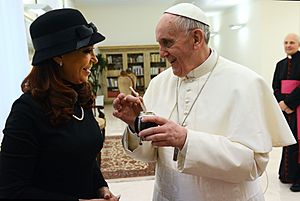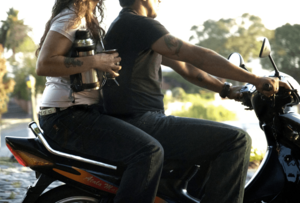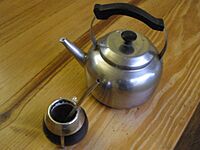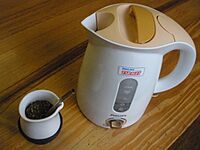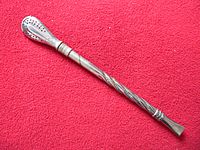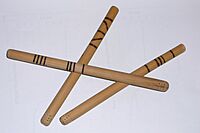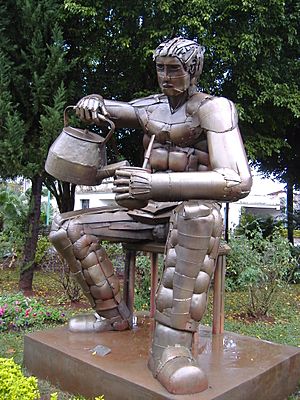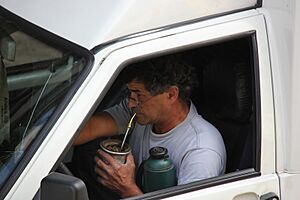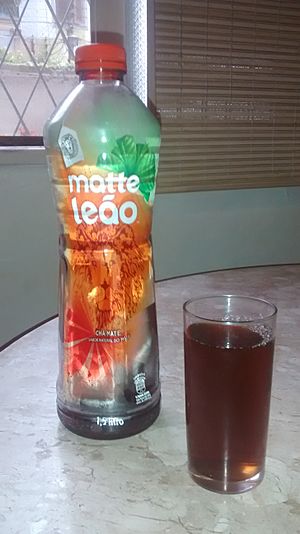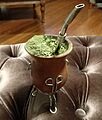Mate (drink) facts for kids

|
|
| Type | Infusion, hot |
|---|---|
| Country of origin | The territory of the Guaraní people (present-day Paraguay, the Misiones province of Argentina, southeastern Bolivia, southern Brazil and Uruguay) |
| Introduced | Pre-Columbian era. First European written record by Spanish colonizers in the 15th century |
Mate (pronounced MAH-tay) is a popular hot drink from South America. It's like a special herbal tea. People make it by soaking dried leaves from the yerba mate plant (Ilex paraguariensis) in hot water.
This drink is also known as chimarrão or Template:Lang:es. In the Guaraní language, it's called ka’ay. Mate is traditionally served in a container, often made from a calabash gourd. People drink it using a metal straw called a bombilla. You can also find mate in tea bags or as bottled iced tea today.
The Guaraní and Tupi were the first to drink mate. It was especially popular with natives in Paraguay. Today, mate is the national drink of Argentina, Paraguay, and Uruguay. It's also enjoyed in parts of Bolivia, Brazil, and Chile. Immigrants even brought mate to countries like Lebanon and Syria.
Contents
Tools for Drinking Mate
To enjoy mate, you need a few special tools.
The Bombilla
The metal straw used for mate is called a bombilla or bomba. Traditionally, these straws were made of silver. Now, they are often made from nickel silver, stainless steel, or even hollow cane.
The bombilla is clever because it works as both a straw and a sieve. The end that goes into the drink has small holes or slots. These let the liquid pass through but block the tiny pieces of yerba mate leaves. This way, you only drink the smooth tea.
The Mate Container
The cup or container that mate is served in is also called a mate. It's most commonly made from a calabash gourd. However, people also make mate containers from other materials, like wood, ceramic, or even metal. In some areas, they use a cattle horn called a guampa.
History of Mate
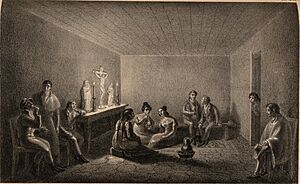
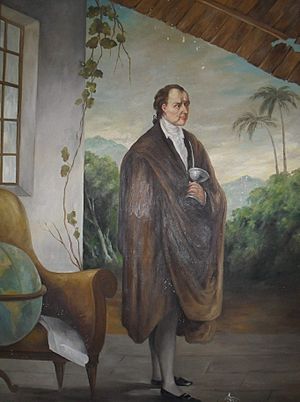
Mate was first enjoyed by the native Guaraní in areas that are now Paraguay, Brazil, Argentina, Bolivia, and Uruguay. The Tupí also helped spread its use. The plant's scientific name, Ilex paraguariensis, comes from Paraguay.
Europeans started drinking mate after the Spanish arrived in the late 1500s. It became popular with both Spanish settlers and the Guaraní. By the 1600s, mate drinking had spread to other parts of South America, like Peru and Chile. Mate became a very important product for Paraguay.
Later, Jesuit missionaries learned how to grow yerba mate on farms. This caused some competition with those who harvested it from the wild. After the Jesuits left in the 1770s, their mate farms fell apart.
Brazil then became the biggest producer of mate. In the late 1800s and early 1900s, people in Brazil and Argentina learned how to grow the plant again on large farms. When Brazil focused on coffee in the 1930s, Argentina became the top producer.
As of 2018, Argentina produces most of the world's mate (56–62%). Brazil is next (34–36%), and Paraguay produces about 5%. Uruguay drinks the most mate per person, about 19 liters each year!
What's in a Name?
The English word "mate" comes from the Spanish word mate. This word means both the drink and the container it's served in. The Spanish word comes from the Quechua word mati, which means "calabash gourd."
You might see "maté" or "mate" in English. The little mark over the 'e' (é) in "maté" helps you know to say it with two syllables, like "mah-TAY." This is different from the English word "mate" (like a friend). In Spanish, the accent mark is not used because the first part of the word is stressed.
In Brazil, mate prepared in the traditional way is called chimarrão. In Argentina and Uruguay, people also use the term "mate amargo" (bitter mate). The Spanish word cimarrón means "wild" or "untamed." It was used to describe the strong, unsweetened drink that the native people drank.
Mate Culture
Mate is a big part of the culture and identity in many South American countries. It's the national drink of Paraguay, Argentina, and Uruguay. In Paraguay, people also drink it with ice-cold water, which is called tereré.
Drinking mate is a common social activity. Families and friends often share mate in Paraguay, Argentina, Brazil, Uruguay, southern Chile, and eastern Bolivia. It's seen as a tradition from the Guaraní people. It's also linked to the gauchos, who were cowboys of the South American plains. Argentina even celebrates National Mate Day every November 30th since 2015.
In Brazil, especially in Rio de Janeiro, mate is popular as an iced tea. You'll often find beach vendors selling it. There's even a park in Brazil, Parque Histórico do Mate, that teaches people about growing mate in a way that protects the environment.
How to Prepare Mate
Preparing mate is a simple process. You fill a container with yerba mate leaves, pour hot (but not boiling) water over them, and drink it with a bombilla. The bombilla acts as a filter.
The way you prepare mate can be a bit different from place to place. But most methods have similar steps. The drink is usually made in a gourd, also called a mate or cuia.
Step-by-Step Preparation
First, fill the gourd about halfway to three-quarters full with yerba mate. If you use too much or too little, the mate might not taste as good. You can also add other herbs (called yuyo) for flavor or health benefits. This is common in Paraguay.
Next, cover the opening of the gourd with your palm. Turn the mate upside down and shake it gently for a short time. This makes the finest, powdery bits of the yerba settle towards your hand.
Then, tilt the mate to a sideways angle, with the opening slightly higher than the bottom. Shake it gently from side to side. This helps the yerba settle so that the finest particles are near the opening, and the leaves are layered on one side. The bigger stems create a barrier.
This careful settling helps make sure each sip is smooth. The finest particles will be far from the straw's filter.
Now, it's time to put in the straw. First, you can wet the yerba by pouring a little cool water into the empty space in the gourd. Let the water soak in. This makes the yerba stronger and helps it keep its shape. Then, insert the bombilla into the deepest part of the yerba, near the opposite side of the gourd. Make sure to cover the top of the straw with your thumb when you put it in.
Brewing the Mate
After the straw is in, you can start brewing. If you put the straw into dry yerba, first add cool water and let it soak in completely (about 2-3 minutes). Using cool water first is important. It protects the yerba mate from getting too hot and losing its good nutrients.
Then, carefully pour hot water (around 70 to 85 degrees Celsius, never boiling) into the empty space in the gourd. Pour it until it almost reaches the top. Try to keep the top of the yerba mound dry.
Once the hot water is added, your mate is ready to drink! You can refill it many times. When the flavor starts to fade, it's called lavado (washed out). You can then push the yerba mound to the other side of the gourd and add water there. This helps bring back the flavor for more refills. This is called "reformar o/el mate" (reforming the mate).
Mate Etiquette
Mate is usually drunk in a social setting, like with family or friends. Everyone shares the same gourd (cuia/mate) and straw (bomba/bombilla).
One person, called the cebador (server), prepares and serves the mate. This is often the host. The cebador fills the gourd and drinks the first mate completely. This makes sure it's good quality and doesn't have too many small bits. Sometimes, the cebador drinks the second one too if it's not quite right.
Then, the cebador refills the gourd and passes it to the person on their right. That person drinks all the mate and returns the gourd without saying "thank you." Saying "thank you" (gracias or obrigado) means you've had enough. The only time the order changes is if a new guest joins the group.
The group keeps passing the mate around until it becomes lavado (washed out) and loses its flavor. This usually happens after about 10 or more refills. If you've had enough mate, you politely thank the cebador when you return the gourd.
It's considered rude for anyone but the cebador to move the bombilla or mess with the mate. If someone takes too long to drink, others might playfully say, "no es un micrófono" ("it's not a microphone"), meaning they're holding it too long!
Some people like to add sugar or honey to their mate. This is called mate dulce (sweet mate). Mate without sugar is called mate amargo (bitter mate). Some people also add lemon or orange peel, or other herbs.
Traditional gourds are common, but you can also find mate containers made of wood, bamboo, ceramic, or metal. Some gourds are beautifully decorated with silver.
Other Facts About Mate
Mate is rich in caffeine, which is a stimulant. It also contains other natural compounds.
You might hear people say that mate has a special stimulant called mateína. However, scientists have found that mateína isn't a real substance. The stimulating effect comes from the caffeine and other natural chemicals in the yerba mate plant.
Legendary Origins
The Guaraní people, who first drank mate, have a special legend about how it began. The story says that the Goddesses of the Moon and the Cloud came to visit Earth one day. An old man saved them from a yaguareté (jaguar) that was going to attack them. To thank him, the goddesses gave him a new kind of plant. From this plant, he could make a "drink of friendship."
Different Ways to Drink Mate
There are several ways to enjoy mate.
Tereré
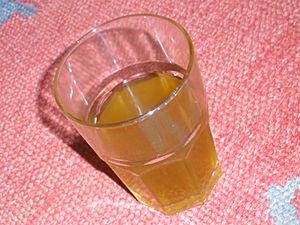
One popular variation is tereré. This is made with specially cut dry leaves and very cold water. You can also add lemon or other fruit juice. Tereré is very common in Paraguay, northeastern Argentina, and parts of Brazil.
Mate Cocido
Another way to drink mate is mate cocido (boiled mate), or chá mate in Brazil. This is made like regular tea, using a teabag or loose leaves, and drunk from a cup or mug. People often add sugar and milk to it.
Regional Differences
In Uruguay and Brazil, the traditional mate gourd is usually large. In Argentina, especially in Buenos Aires, the gourd is smaller. People in Argentina sometimes add sugar for flavor.
In Uruguay, it's common to see people walking around with a mate and a thermos of hot water. In some parts of Argentina, gas stations even offer free hot water for travelers to make mate during their journey.
Mate Around the World
Mate is also popular in some parts of Syria, Lebanon, and other Eastern Mediterranean countries. This tradition came from Syrians and Lebanese who moved to South America long ago. They brought the custom back home with them. Syria is actually the biggest importer of yerba mate in the world!
In North America, mate has become more popular. You can find loose mate and bottled mate drinks in many stores. Some bottled versions are sweetened and carbonated, like soda.
Sweet vs. Bitter Mate
In some parts of South America, especially Paraguay, Uruguay, southern Brazil, and parts of Argentina and Bolivia, people prefer bitter mate. This is called cimarrón and means it's unsweetened. Many people believe this is the "proper" way to drink mate.
For sweet mate (mate dulce), people add sugar or honey to their taste. This is common in regions of Argentina like Santiago del Estero and Córdoba. In Chile, sweet mate is popular in rural areas. A trick is to add the sugar to the edge of the yerba, not all over it. Sometimes, only the first mate is sweetened to cut the initial bitterness.
In Paraguay, a sweet mate variant is made by caramelizing sugar and adding milk. Natural sweeteners like ka'á he'é (Stevia rebaudiana) leaves are also used, especially in Paraguay.
It's believed that a gourd used for bitter mate should not be used for sweet mate. People think the sugar would ruin the taste for future bitter mate preparations.
Materva is a sweet, fizzy soft drink based on yerba mate. It was created in Cuba in 1920 and is now a popular drink in Cuban culture in Miami, Florida.
Images for kids
See also
 In Spanish: Mate (infusión) para niños
In Spanish: Mate (infusión) para niños
- Black drink
- Mate con malicia (Chilean beverage)
- Ilex guayusa (caffeinated beverage made from another holly tree)
- List of Brazilian dishes
- Mate de coca
- Club-Mate
- Materva
- Guayakí
- Yaupon


